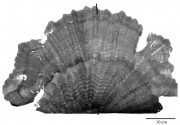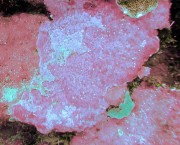Dr Katharina Fabricius
Author of


Crustose coralline algae (CCA) are rock-hard calcareous red algae that fulfill two key functional roles in coral reef ecosystems: they contribute significantly to reef calcification and cementation, and they induce larval settlement of many benthic organisms.
A study of CCA cover on the Great Barrier Reef (GBR) shows strong differences in cover across the Continental Shelf. Mean CCA cover is <1% on the inner third of the GBR, compared to >20% on the outer half of the shelf. CCA cover is also affected by the amount of sediment deposited, water clarity, and the steepness of the reef slopes. Within each cross-shelf zone, the cover of CCA is higher on reefs with low sediment deposits than on reefs with high levels of sedimentation. On the inner third of the shelf, the most sediment-exposed reefs are unsuitable habitats for most CCA. This inverse relationship between CCA and sediment has implications for the recruitment of CCA-specialised organisms, and for the balance between reef accretion and erosion.




